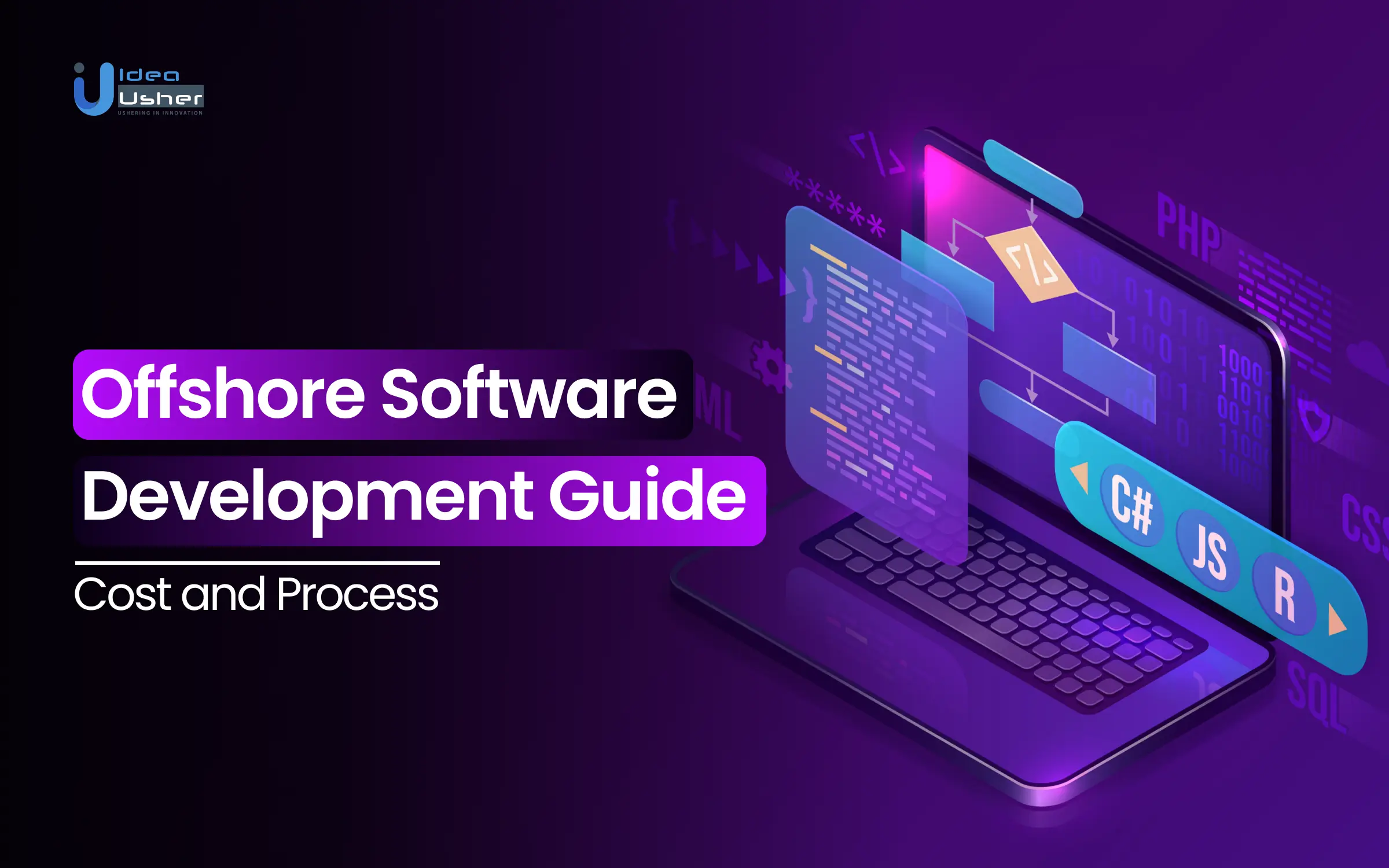Offshore software development has become a strategic approach for businesses aiming to build high-quality digital solutions while optimizing costs. With technology advancing rapidly, companies are no longer limited to hiring in-house teams or local developers. Instead, they can collaborate with skilled professionals from different parts of the world, benefiting from cost savings, diverse expertise, and increased scalability.
Outsourcing software development provides cost efficiency and access to global talent but entails risks, such as potential project failures. Someone who experienced issues with an offshore company may choose a different firm, but not all are so fortunate. Despite these challenges, many startups succeed by understanding the landscape, choosing the right team, and applying effective management practices.
In this guide, we will explore the fundamentals of offshore software development, including cost factors, hiring processes, and essential considerations before partnering with an offshore team. Whether you are a startup building your first product or an established enterprise optimizing your development efforts, this comprehensive guide will help you make informed decisions and avoid common pitfalls.
What is Offshore Software Development?
Offshore software development refers to the practice of outsourcing software development tasks to a team or company in another country, typically in regions with lower labor costs. Businesses collaborate with offshore developers to design, develop, test, and maintain software solutions while leveraging cost savings, skilled talent, and faster time-to-market.
Offshore vs. Nearshore vs. Onshore Development
Understanding the differences between offshore, nearshore, and onshore development is crucial when choosing the right outsourcing model:
- Offshore Development: Hiring a team in a distant country, often with significant cost savings but requiring effective communication strategies due to time zone differences.
- Nearshore Development: Outsourcing to a neighboring country or a region in a similar time zone, balancing cost and convenience.
- Onshore Development: Hiring developers within the same country offers easier communication but often at higher costs.
Industries Benefiting from Offshore Development
Several industries rely on offshore software development to build innovative solutions while managing operational expenses:
- FinTech: Developing secure payment systems, digital banking apps, and blockchain solutions.
- Healthcare: Creating telemedicine platforms, electronic health records (EHR) systems, and AI-driven diagnostics.
- E-commerce: Building scalable online stores, mobile shopping apps, and AI-powered recommendation engines.
- SaaS: Developing cloud-based applications with continuous updates and multi-platform compatibility.
Offshore development enables companies across these industries to access top-tier expertise while maintaining cost efficiency and agility in software innovation.
Why do Companies Hire Offshore Developers?
According to the Verified Market Research, in 2024, the market was valued at USD 122 billion and is projected to reach USD 283 billion by 2031, growing at a CAGR of 10.13% from 2024 to 2031. This expansion highlights the increasing reliance of businesses on offshore development to enhance operational efficiency and reduce costs.
The offshore software development market has witnessed substantial growth in recent years. According to Deloitte, 70% of companies use outsourcing services primarily to save costs while also gaining access to specialized expertise and scalable talent pools.
When to outsource software development?
A business can hire the offshore software development firms anytime, but these are some important times they can consider to hire:
1. Brainstorm Ideas
When you have a very impressive idea and you have to develop it to kickstart your business, you should hire an offshore software development company. That company can help you excel in your plan with a detailed guide from experienced developers and market researchers.
2. Want to Develop the App
Suppose you are starting a new business or you are already a renowned enterprise and need to develop an app or software to maximize your business plan. In that case, that is the main time to hire experienced offshore software developers.
3. Implementation of Other Technologies
You have already released your app in the market, but there are some technologies you want to add to your app or software. Instead of hiring potential developers, you can hire experienced offshore software developers from different regions so that you can save the estimated cost and get other types of talented developers.
How to Hire Offshore Software Developers: A Step-by-Step Process
Hiring offshore software developers requires a structured approach to ensure quality, cost-efficiency, and long-term success. Businesses must carefully plan each stage, from defining project requirements to monitoring performance. Below is a step-by-step guide to hiring offshore developers effectively.

Step 1: Identify Your Hiring Needs
The first step in offshore hiring is to clearly define the roles, skills, and team size required for your project. Whether you need front-end developers, backend engineers, quality assurance specialists, or full-stack experts, it is essential to outline the necessary technologies and expertise.
Additionally, selecting the right engagement model is critical:
- Dedicated Team: Suitable for long-term projects requiring full control over resources.
- Project-Based Model: Best for fixed-scope projects with a predefined budget and timeline.
- Hybrid Model: Combines offshore resources with in-house developers for flexibility.
Understanding these needs allows businesses to streamline the recruitment process and select the most suitable offshore development partner.
Step 2: Research and Shortlist Offshore Vendors
Choosing the right offshore development team requires thorough research and evaluation. Businesses should explore reliable platforms such as Clutch, GoodFirms, and LinkedIn or seek recommendations from industry peers.
Key criteria for evaluating offshore vendors include:
- Portfolio: Assess industry-specific experience and project relevance.
- Client Reviews and Case Studies: Verify credibility through testimonials and past work.
- Data Security Compliance: Ensure adherence to GDPR, ISO 27001, and other security standards.
- Pricing Transparency: Review cost structures to avoid hidden charges.
Shortlisting vendors based on these factors helps ensure that the chosen partner aligns with business objectives and technical requirements.
Step 3: Conduct Interviews and Technical Assessments
Once potential offshore developers or agencies are identified, the next step is screening and evaluation. A multi-stage assessment process ensures that only skilled professionals are selected.
The screening process typically includes:
- Resume Review and Cultural Fit Assessment: Evaluating candidates based on past experience, communication skills, and alignment with company values.
- Technical Assessment: Conducting a live coding session or take-home test to assess programming skills and problem-solving abilities.
- Final Interview with Technical Lead: A deeper discussion about expertise, project expectations, and technical decision-making skills.
It is crucial to watch for red flags such as vague answers, lack of certifications, and poor communication skills. These indicators can help avoid unreliable vendors and unqualified developers.
Step 4: Finalize Contracts and Legal Agreements
After selecting the offshore development team, businesses must establish clear legal agreements to protect intellectual property and ensure smooth collaboration.
Key contractual documents include:
- Non-Disclosure Agreement (NDA): Protects sensitive business information.
- Intellectual Property Rights Clause: Ensures full ownership of the developed software.
- Service-Level Agreement (SLA): Defines performance expectations, deadlines, and penalty clauses.
- Payment Terms: Outlines milestone-based or hourly payment models.
Having legally binding agreements in place mitigates risks, ensures transparency, and protects business interests.
Step 5: Onboard and Integrate the Offshore Team
A well-planned onboarding process is essential for ensuring smooth collaboration and productivity.
Best practices for effective onboarding include:
- Assigning a Single Point of Contact: A Project Manager or Team Lead should oversee communication and coordination.
- Setting Up Collaboration Tools: Platforms like Slack, Jira, Trello, and GitHub streamline workflow management.
- Aligning Time Zones: Ensuring a minimum of four to five hours of overlapping work time facilitates real-time discussions.
- Conducting a Kickoff Meeting: Defining project goals, key performance indicators (KPIs), workflows, and reporting structures enhances alignment.
A structured onboarding process ensures clarity, efficiency, and a seamless transition into the development phase.
Step 6: Monitor Performance and Scale
To maintain efficiency and quality, businesses must continuously monitor offshore team performance. Establishing performance tracking metrics is key to ensuring consistent progress.
Important performance indicators include:
- Code Quality: Measured through bug rates, pull request reviews, and sprint velocity.
- Communication and Responsiveness: Evaluated through response times and collaboration effectiveness.
- Deadline Adherence: Ensuring timely milestone completion.
Regular bi-weekly performance reviews and retrospective meetings allow businesses to address issues, optimize workflows, and determine if team expansion is required.
Work with Ex-MAANG developers to build next-gen apps schedule your consultation now
Offshore Development Team Cost: Full Breakdown
Offshore software development continues to be a strategic approach for businesses aiming to optimize costs while accessing a global talent pool. Below is a comprehensive breakdown of the cost components associated with offshore development teams in 2025.
A. Primary Cost Components
Offshore software development rates vary significantly across different regions, influenced by factors such as local economic conditions, availability of skilled talent, and prevailing market demand. Below is a breakdown of average hourly rates in USD for various regions:
| Region | Average Hourly Rates (USD) |
| Asia | $18 – $40 |
| Eastern Europe | $25 – $60 |
| Latin America | $30 – $50 |
| Oceania | $60 – $200 |
| North America | $50 – $300 |
| Western Europe | $45 – $300 |
Note: These figures are approximate and can vary based on specific countries within each region and the developers’ expertise.
Engagement Model Costs
- Dedicated Team: Engaging a full-time dedicated developer typically costs between $3,500 and $15,000 per month, depending on their role and experience.
- Fixed Price: This model often includes a 15–20% premium to cover project risks and uncertainties.
- Hybrid Model: Combines local project management oversight with offshore execution, resulting in custom pricing tailored to the project’s specific needs.
Hidden Costs to Budget For
- Recruitment Fees: When utilizing agencies, expect to pay recruitment fees ranging from 10–20% of the developer’s annual salary.
- Infrastructure and Tools: Budget for expenses related to development tools and platforms, such as AWS subscriptions and GitHub licenses.
- Compliance Certifications: Ensure adherence to regulations like GDPR and HIPAA, which may involve additional certification costs.
B. ROI Calculation Example
Consider a scenario involving a 10-member development team engaged over six months:
U.S.-Based Team Cost: Approximately $500,000.
Offshore Team in India Cost: Approximately $100,000.
Total Savings: By opting for the offshore model, the company realizes savings of around $400,000, equating to an 80% reduction in development costs, while maintaining comparable quality standards.
Key Points to Remember When Hiring Offshore Software Developers
Selecting the right offshore development partner is essential to achieving project success. A well-qualified team can enhance efficiency, optimize costs, and ensure high-quality deliverables. Below are eight critical factors to consider when hiring an offshore development company.
1. Experience That Delivers Results
Before hiring an offshore development company, verify their experience in your specific industry (FinTech, Healthcare, E-commerce, SaaS, etc.). A team that has worked on similar projects understands industry regulations, challenges, and best practices.
- Visit the preferred development companies’ “About Us” Page to learn more about the company.
- Look for vendors with at least three years of relevant experience.
- Request three to five case studies showcasing successful projects with measurable outcomes.
A proven track record reduces risks and ensures the offshore team can handle complex challenges effectively.
2. Technology Expertise
Every software project requires specific technologies, frameworks, and tools. Before hiring, assess the team’s expertise in your needed tech stack, such as blockchain technology, AI Development & Integration, React, Node.js, AWS, Python, etc.
- Confirm their ability to work with AI/ML, Web3, AR/VR, blockchain, IoT, or any specialized technologies if needed.
- Check for certifications, portfolios, or R&D efforts that demonstrate expertise.
The right technical proficiency ensures that your software is built with scalable, secure, and future-proof technologies.
3. Development Cost Structure
Offshore development can be cost-effective, but unclear pricing can lead to unexpected expenses.
- Compare fixed-price vs. time-and-materials pricing models to determine what suits your project.
- Clarify maintenance, support, and post-launch costs to avoid hidden fees.
Check out our detailed blog about app development cost to get a proper understanding.
A transparent pricing model helps with budgeting accurately and ensures that no unexpected costs arise later.
4. Flexibility to Scale Your Business
Your project’s needs may change over time, requiring a development team that can scale up or down quickly.
- Ensure that the offshore vendor offers on-demand scaling of developers as needed.
- Check how easily they adapt to changing requirements and unforeseen challenges.
A flexible offshore team helps businesses scale efficiently without delays or resource constraints.
5. Commitment
A strong offshore development partner is invested in your project’s long-term success.
- Look for Service Level Agreements (SLAs) with clear performance guarantees.
- Verify their post-launch support terms, including bug fixes, updates, and maintenance.
A committed team ensures on-time delivery, high-quality performance, and ongoing support even after project completion.
6. Time-Efficient Processes
Project delays can lead to lost opportunities and increased costs. Ensuring structured workflows and clear timelines is crucial.
- Demand a detailed development roadmap with defined milestones.
- Ask about their quality assurance (QA) and testing processes to prevent post-launch issues.
A streamlined DevOps-powered approach ensures that development is 40% faster than industry standards.
7. Seamless Communication
Poor communication can lead to misunderstandings, delays, and project failure.
- Confirm that the offshore team has strong English proficiency for clear discussions.
- Check if they use Slack, Zoom, Jira, or other project management tools for efficient collaboration.
Effective communication ensures smooth workflows, faster decision-making, and better project alignment.
8. No Lock-In Legalities
Legal clarity is essential to ensure full ownership of your software without unexpected obligations.
- Review contract termination clauses to avoid vendor lock-in.
- Ensure 100% Intellectual Property (IP) ownership is transferred to your business.
Clear legal agreements prevent ownership disputes and ensure long-term control over your product.
Challenges of offshore software development
While offshore software development offers numerous benefits, it also comes with challenges that businesses must address for a successful collaboration.
1. Client Has Unclear Goals
Vague project objectives can lead to confusion and inefficiencies. Without clear documentation and well-defined requirements, the offshore team may struggle to meet expectations. A structured project roadmap helps ensure alignment.
2. Unrealistic Expectations
Expecting rapid development at minimal costs without considering project complexity can affect quality. While offshore development is cost-effective, proper planning, realistic timelines, and budget discussions are essential for success.
3. Time Zone & Distance
Different time zones can delay communication and slow progress. Scheduling overlapping working hours, setting clear deadlines, and using collaboration tools help minimize these issues.
4. Poor Communication
Language barriers and cultural differences can lead to misunderstandings and project delays. Establishing structured communication channels, regular updates, and clear documentation ensures smooth collaboration.
5. Not Enough Attention from Client
A hands-off approach can lead to misalignment between the client’s vision and the final product. Regular feedback, milestone approvals, and ongoing engagement are necessary to keep the project on track.
6. Client Doesn’t Participate in Methodology
Offshore teams follow structured methodologies like Agile, requiring client involvement. Lack of participation in sprint reviews and feedback sessions can disrupt workflow. Staying engaged ensures timely improvements and a successful outcome.
What are the benefits of offshore software development?
Offshore software development provides businesses with numerous advantages, making it a strategic choice for cost-effective and high-quality software solutions.
- Cost Efficiency: Reduces development costs by hiring skilled professionals from regions with lower labor costs.
- Access to a Global Talent Pool: Provides access to highly skilled developers with expertise in various technologies.
- Faster Time to Market: Different time zones enable round-the-clock development, speeding up project completion.
- Scalability: Easily scale teams up or down based on project needs without long-term commitments.
- Focus on Core Business Operations: Allows businesses to delegate software development while focusing on strategic goals.
- High-Quality Development: Many offshore teams specialize in advanced technologies, ensuring top-tier software solutions.
- Flexibility in Hiring Models: Offers multiple engagement models like dedicated teams, fixed pricing, or hourly hiring.
- Improved Productivity: Offshore teams often follow Agile methodologies, enhancing efficiency and workflow management.
- Access to the Latest Technologies: Offshore developers stay updated with modern tools, frameworks, and best practices.
- Reduced Infrastructure Costs: Eliminates expenses related to in-house development, such as office space, hardware, and software.
How to Manage Your Offshore Developers?
Effective management of offshore developers is essential to ensure productivity, collaboration, and successful project delivery. Here are some key strategies to optimize offshore development:
1. Ensure That You Are on the Same Page
Aligning expectations from the start helps prevent misunderstandings and project misalignment. Clearly define project goals, milestones, and deliverables to ensure both parties have a shared vision. Regular check-ins, well-documented requirements, and detailed project roadmaps keep everyone informed and focused on common objectives.
2. Agree on Tracking Tools
Using project management and tracking tools ensures transparency and real-time progress monitoring. Platforms like Jira, Trello, and Asana help assign tasks, track deadlines, and manage workflows efficiently. Agreeing on a unified toolset helps all stakeholders stay updated and minimizes miscommunication.
3. Eliminate Micromanagement
Trusting the offshore team to work independently fosters productivity and innovation. Instead of micromanaging daily tasks, set clear guidelines, establish performance metrics, and allow the team to take ownership of their responsibilities. Regular progress updates and milestone reviews ensure accountability without excessive supervision.
Conclusion
Offshore software development continues to be a cost-effective and scalable solution for businesses looking to build high-quality applications without the overhead of in-house teams. By leveraging a global talent pool, companies gain access to skilled professionals at competitive rates, enabling faster development cycles and increased efficiency.
When hiring offshore teams, consider location, communication, and security. Adopting structured hiring and agile methods boosts benefits and minimizes risks. A suitable partner helps save costs, accelerate time-to-market, and maintain competitiveness. With rising software demand, offshore development fosters innovation and growth.
How Will IdeaUsher Help in Offshore Software Development?
IdeaUsher provides end-to-end offshore software development services, ensuring cost-effective, high-quality solutions tailored to your business needs.
Our team, with 500,000+ hours of experienced engineers from ex-MAANG/FAANG professionals, specializes in AI, blockchain, cloud computing, and enterprise-grade software development. We help businesses scale efficiently by offering dedicated offshore teams with expertise in full-stack development, DevOps, and emerging technologies.
With a focus on transparency, security, and agile methodologies, IdeaUsher ensures seamless collaboration through structured project management, real-time progress tracking, and clear communication channels.
Our offshore development services include custom software development, AI-powered automation, and cloud-based solutions, helping businesses reduce operational costs while maintaining high performance and security.
Partner with IdeaUsher to leverage global talent, accelerate development timelines, and build scalable, future-ready software solutions.
Work with Ex-MAANG developers to build next-gen apps schedule your consultation now
FAQs
Q1. Why should you offshore your software project?
Offshoring allows businesses to access a global talent pool at a significantly lower cost compared to in-house development. It enables faster time-to-market, scalability, and 24/7 development cycles due to time zone advantages. Companies can focus on core business operations while offshore experts handle technical development efficiently.
Q2. How can you handle security and confidentiality with the offshore team?
To ensure security and confidentiality, businesses should sign NDAs, IP agreements, and compliance contracts (GDPR, HIPAA). Working with certified vendors who follow industry security standards like ISO 27001 helps mitigate risks. Using encrypted communication channels, secure cloud infrastructure, and role-based access controls further enhances data protection.
Q3. How can you track the project progress?
Project progress can be monitored through agile methodologies, sprint planning, and regular updates using collaboration tools like Jira, Trello, or Asana. Daily standups, weekly reports, and real-time dashboards help maintain transparency and keep stakeholders informed. Performance metrics such as sprint velocity, bug rates, and milestone completion ensure accountability.
Q4. How much does offshore software development cost?
Offshore software development costs vary by region, developer expertise, and project complexity. On average, hourly rates range from $15 – $50 in Asia, $25 – $70 in Eastern Europe, and $30 – $80 in Latin America. A full-time offshore developer may cost between $3,500 – $15,000 per month or the total estimated cost varies between $10,000 – $100,000, depending on skills and experience.




















